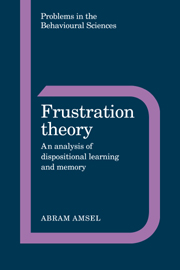Book contents
- Frontmatter
- Contents
- Preface
- List of abbreviations
- 1 Introduction: reward-schedule effects and dispositional learning
- 2 Motivational and associative mechanisms of behavior
- 3 Frustration theory: an overview of its experimental basis
- 4 Survival, durability, and transfer of persistence
- 5 Discrimination learning and prediscrimination effects
- 6 Alternatives and additions to frustration theory
- 7 Ontogeny of dispositional learning and the reward-schedule effects
- 8 Toward a developmental psychobiology of dispositional learning and memory
- 9 Summing up: steps in the psychobiological study of related behavioral effects
- 10 Applications to humans: a recapitulation and an addendum
- Appendix: some phenomena predicted or explained by frustration theory
- References
- Name index
- Subject index
7 - Ontogeny of dispositional learning and the reward-schedule effects
Published online by Cambridge University Press: 20 March 2010
- Frontmatter
- Contents
- Preface
- List of abbreviations
- 1 Introduction: reward-schedule effects and dispositional learning
- 2 Motivational and associative mechanisms of behavior
- 3 Frustration theory: an overview of its experimental basis
- 4 Survival, durability, and transfer of persistence
- 5 Discrimination learning and prediscrimination effects
- 6 Alternatives and additions to frustration theory
- 7 Ontogeny of dispositional learning and the reward-schedule effects
- 8 Toward a developmental psychobiology of dispositional learning and memory
- 9 Summing up: steps in the psychobiological study of related behavioral effects
- 10 Applications to humans: a recapitulation and an addendum
- Appendix: some phenomena predicted or explained by frustration theory
- References
- Name index
- Subject index
Summary
In D. O. Hebb's last book, Essays on Mind (1980), there is the following passage:
The argument [can be made] that the behavioral signs of mind and consciousness are evident only in the mammals, with the possible exception of some of the larger-brained birds; that relatively small-brained mammals like the rat or the hamster may have very small minds (like the penguins of Anatole France's Penguin Island, to whom the Lord gave souls but of a smaller size) – but still minds, whereas fish and reptiles, and most birds, seem to be reflexively programmed and give little evidence of that inner control to which the term mind refers. The best evidence of continuity, in the development from lower to higher mammals, is to be found not only in their intellectual attainments, their capacities for learning and solving problems, but also in their motivations and emotions. Man is evidently the most intelligent animal but also, it seems, the most emotional.
(p. 47)This statement, in Hebb's colorful prose, is an example, in phylogenetic terms, of a kind of thinking that, in its ontogenetic counterpart as well as in levels of functioning in the adult mammal, is seen increasingly in our field (e.g., Amsel & Stanton, 1980; Bitterman, 1960, 1975; Livesey, 1986; Schneirla, 1959; Wickelgren, 1979). My own point (Amsel, 1972b) was (and is) that there is a level of classical conditioning that is purely dispositional, involves implicit memory, and is less dependent on mediation than what is usually called Pavlovian conditioning, and that both levels involve a lesser degree of mediation than instrumental learning.
- Type
- Chapter
- Information
- Frustration TheoryAn Analysis of Dispositional Learning and Memory, pp. 137 - 173Publisher: Cambridge University PressPrint publication year: 1992

